Analysis of the Evolution of Land Use Carbon Metabolism Patterns and the Response to Urban Form Changes in Haikou, China
Abstract
1. Introduction
2. Literature Review
2.1. Urban Carbon Metabolism
2.2. Urban Form
3. Materials and Methods
3.1. Study Areas and Data Sources
3.2. Methods
3.2.1. Carbon Emission Accounting
3.2.2. Carbon Sink Accounting
3.2.3. Spatial Patterns of Carbon Metabolism
3.2.4. Response of Carbon Metabolism Patterns to Urban Morphological Change
3.3. Limitations
4. Results
4.1. Carbon Metabolism Accounting Results
4.2. Spatial Distribution Patterns of Carbon Metabolism
4.3. Evolution of Urban Morphology
4.4. Spatial Autocorrelation Analysis of Carbon Metabolism
4.4.1. Spatially Aggregated and Heterogeneous Regions of Carbon Metabolism
4.4.2. Changes in the Autocorrelation Patterns of Carbon Metabolism
4.5. Response of Carbon Metabolism Patterns to Urban Morphological Changes
5. Discussion
5.1. Analysis and Comparison of Results
5.2. Policy Implications
6. Conclusions
Author Contributions
Funding
Data Availability Statement
Acknowledgments
Conflicts of Interest
References
- Chen, W.; Gu, T.; Fang, C.; Zeng, J. Global urban low-carbon transitions: Multiscale relationship between urban land and carbon emissions. Environ. Impact Assess. Rev. 2023, 100, 107076. [Google Scholar] [CrossRef]
- Bai, X.; Blanco, H.; Gurney, K.R.; Kılkış, Ş.; Lucon, O.; Murakami, J.; Pan, J.; Sharifi, A.; Yamagata, Y.; White, L. Urban systems and other settlements. In Climate Change 2022-Mitigation of Climate Change; Cambridge University Press: Cambridge, UK, 2022; pp. 861–952. [Google Scholar]
- Geremicca, F.; Bilec, M.M. Searching for new Urban Metabolism techniques: A review towards future development for a city-scale Urban Metabolism Digital Twin. Sustain. Cities Soc. 2024, 107, 105445. [Google Scholar] [CrossRef]
- Wolman, A. The metabolism of cities. Sci. Am. 1965, 213, 178–193. [Google Scholar] [CrossRef]
- Baccini, P. Understanding regional metabolism for a sustainable development of urban systems. Environ. Sci. Pollut. Res. 1996, 3, 108–111. [Google Scholar] [CrossRef]
- Chen, S.Q.; Long, H.H.; Chen, B. Assessing urban low-carbon performance from a metabolic perspective. Sci. China Earth Sci. 2021, 64, 1721–1734. [Google Scholar] [CrossRef]
- Hu, Y.J.; Sun, J.; Zheng, J. Spatiotemporal Analysis of Urban Carbon Metabolism and Its Response to Land Use Change: A Case Study of Beijing, China. Atmosphere 2023, 14, 1305. [Google Scholar] [CrossRef]
- Hong, C.; Burney, J.A.; Pongratz, J.; Nabel, J.E.; Mueller, N.D.; Jackson, R.B.; Davis, S.J. Global and regional drivers of land-use emissions in 1961–2017. Nature 2021, 589, 554–561. [Google Scholar] [CrossRef]
- Wei, J.; Xia, L.; Chen, L.; Zhang, Y.; Yang, Z. A network-based framework for characterizing urban carbon metabolism associated with land use changes: A case of Beijing city, China. J. Clean. Prod. 2022, 371, 133695. [Google Scholar] [CrossRef]
- Tang, X.; Xiao, J.; Ma, M.; Yang, H.; Li, X.; Ding, Z.; Yu, P.; Zhang, Y.; Wu, C.; Huang, J.; et al. Satellite evidence for China’s leading role in restoring vegetation productivity over global karst ecosystems. For. Ecol. Manag. 2022, 507, 120000. [Google Scholar] [CrossRef]
- Xu, Q.; Yang, R.; Dong, Y.-X.; Liu, Y.-X.; Qiu, L.-R. The influence of rapid urbanization and land use changes on terrestrial carbon sources/sinks in Guangzhou, China. Ecol. Indic. 2016, 70, 304–316. [Google Scholar] [CrossRef]
- Yang, X.; Liu, X. Path analysis and mediating effects of influencing factors of land use carbon emissions in Chang-Zhu-Tan urban agglomeration. Technol. Forecast. Soc. Change 2023, 188, 122268. [Google Scholar] [CrossRef]
- Liu, J.; Peng, K.; Zuo, C.; Li, Q. Spatiotemporal variation of land-use carbon emissions and its implications for low carbon and ecological civilization strategies: Evidence from Xiamen-Zhangzhou-Quanzhou metropolitan circle, China. Sustain. Cities Soc. 2022, 86, 104083. [Google Scholar] [CrossRef]
- Zeng, X.Y.; Fan, D.L.; Zheng, Y.F.; Li, S.J. Exploring the Differentiated Impact of Urban Spatial Form on Carbon Emissions: Evidence from Chinese Cities. Land 2024, 13, 874. [Google Scholar] [CrossRef]
- Han, X.; Fu, M.; Huang, X. Spatiotemporal Heterogeneity of Land-Use Landscape Pattern Effects on CO2 Emissions at the City-Level Scale in China. Land 2025, 14, 1715. [Google Scholar] [CrossRef]
- Xia, L.; Zhang, Y.; Sun, X.; Li, J. Analyzing the spatial pattern of carbon metabolism and its response to change of urban form. Ecol. Model. 2017, 355, 105–115. [Google Scholar] [CrossRef]
- Wang, C.; Liu, Z.; Du, H.; Zhan, W. Regulation of urban morphology on thermal environment across global cities. Sustain. Cities Soc. 2023, 97, 104749. [Google Scholar] [CrossRef]
- Li, L.; Sun, S.J.; Zhong, L.Y.; Han, J.; Qian, X.P. Novel spatiotemporal nonlinear regression approach for unveiling the impact of urban spatial morphology on carbon emissions. Sustain. Cities Soc. 2025, 125, 106381. [Google Scholar] [CrossRef]
- Fath, B.D.; Strelkovskii, N.; Wang, S.; Chen, B. Assessing urban carbon metabolism using network analysis across Chinese and European cities. Clean. Prod. Lett. 2023, 4, 100042. [Google Scholar] [CrossRef]
- Shan, Y.; Guan, D.; Liu, J.; Mi, Z.; Liu, Z.; Liu, J.; Schroeder, H.; Cai, B.; Chen, Y.; Shao, S.; et al. Methodology and applications of city level CO2 emission accounts in China. J. Clean. Prod. 2017, 161, 1215–1225. [Google Scholar] [CrossRef]
- Li, Y.; Guo, W.; Li, P.; Zhao, X.; Liu, J. Exploring the spatiotemporal dynamics of CO2 emissions through a combination of nighttime light and MODIS NDVI data. Sustainability 2023, 15, 13143. [Google Scholar] [CrossRef]
- Xu, F.; Wang, X.; Li, L. NPP and vegetation carbon sink capacity estimation of urban green space using the optimized CASA model: A case study of five Chinese cities. Atmosphere 2023, 14, 1161. [Google Scholar] [CrossRef]
- Batty, M.; Longley, P.A. Urban shapes as fractals. Area 1987, 19, 215–221. [Google Scholar]
- Deng, X.; Cao, Q.; Wang, L.; Wang, W.; Wang, S.; Wang, S.; Wang, L. Characterizing urban densification and quantifying its effects on urban thermal environments and human thermal comfort. Landsc. Urban Plan. 2023, 237, 104803. [Google Scholar] [CrossRef]
- Li, L.; Deng, Z.; Huang, X. Nonlinear relationship between urban form and transport CO2 emissions: Evidence from Chinese cities based on machine learning. J. Geogr. Sci. 2024, 34, 1558–1588. [Google Scholar] [CrossRef]
- Elzeni, M.; Elmokadem, A.; Badawy, N. Classification of Urban Morphology Indicators towards Urban Generation. Port Said Eng. Res. J. 2021, 26, 43–56. [Google Scholar] [CrossRef]
- Tang, Z.; Wang, Y.; Fu, M.; Xue, J. The role of land use landscape patterns in the carbon emission reduction: Empirical evidence from China. Ecol. Indic. 2023, 156, 111176. [Google Scholar] [CrossRef]
- Lv, K.; Sun, F.; Wang, L. Spatial compactness and carbon emission: Nighttime light satellite-based exposure assessment. Reg. Sci. Policy Pract. 2023, 15, 2089–2106. [Google Scholar] [CrossRef]
- Guo, R.; Leng, H.; Yuan, Q.; Song, S. Impact of Urban Form on CO2 Emissions under Different Socioeconomic Factors: Evidence from 132 Small and Medium-Sized Cities in China. Land 2022, 11, 713. [Google Scholar] [CrossRef]
- Wang, T.; Wei, S. Characteristics and influencing factors of land use transition in Haikou City during 2009–2018. Bull. Soil Water Conserv. 2022, 42, 344–352. [Google Scholar]
- Yang, J.; Huang, X. 30 m annual land cover and its dynamics in China from 1990 to 2019. Earth Syst. Sci. Data 2021, 13, 3907–3925. [Google Scholar] [CrossRef]
- IPCC. 2019 Refinement to the 2006 IPCC Guidelines for National Greenhouse Gas Inventories; Buendia, E., Tanabe, K., Kranjc, A., Baasansuren, J., Fukuda, M., Ngarize, S., Osako, A., Pyrozhenko, Y., Shermanau, P., Federici, S., Eds.; IPCC: Geneva, Switzerland, 2019. [Google Scholar]
- Zheng, Y.; Cheng, L.L.; Wang, Y.F.; Wang, J.Q. Exploring the impact of explicit and implicit urban form on carbon emissions: Evidence from Beijing, China. Ecol. Indic. 2023, 154, 110558. [Google Scholar] [CrossRef]
- International Energy Agency (IEA). An Energy Sector Roadmap to Carbon Neutrality in China; CC BY-NC 3.0 IGO.2021; International Energy Agency: Paris, France, 2021. [Google Scholar]
- Ministry of Ecology and Environment of the People’s Republic of China. Guidelines for Provincial Greenhouse Gas Inventories; Revised Edition; Ministry of Ecology and Environment of the People’s Republic of China: Beijing, China, 2025. (In Chinese) [Google Scholar]
- West, T.O.; Marland, G. A synthesis of carbon sequestration, carbon emissions, and net carbon flux in agriculture: Comparing tillage practices in the United States. Agric. Ecosyst. Environ. 2002, 91, 217–232. [Google Scholar] [CrossRef]
- Zhang, Q.; Tao, X.; Yang, P. Research on carbon emissions from metropolis urban passenger transport and countermeasures. China Popul. Resour. Environ. 2012, 22, 35–42. [Google Scholar]
- Xie, T.; Wang, J. Comparative Study on Carbon Emissions in the Transportation Industry. China Transp. Rev. 2011, 8, 20–24. [Google Scholar]
- Shi, Z.; Wang, Y.; Zhao, Q.; Zhang, L.; Zhu, C. The Spatiotemporal Changes of NPP and Its Driving Mechanisms in China from 2001 to 2020. Ecol. Environ. 2022, 31, 2111. [Google Scholar]
- Piao, S.; Fang, J.; Zhou, L.; Zhu, B.; Tan, K.; Tao, S. Changes in vegetation net primary productivity from 1982 to 1999 in China. Glob. Biogeochem. Cycles 2005, 19, GB2027. [Google Scholar] [CrossRef]
- Duan, X.; Wang, X.; Lu, F.; Ouyang, Z. Carbon sequestration and its potential by wetland ecosystems in China. Acta Ecol. Sin. 2008, 28, 463–469. [Google Scholar]
- Fang, J.; Yu, G.; Liu, L.; Hu, S.; Chapin, F.S., III. Climate change, human impacts, and carbon sequestration in China. Proc. Natl. Acad. Sci. USA 2018, 115, 4015–4020. [Google Scholar] [CrossRef]
- He, Y.; Jiang, Y.; Dan, L.; Ji, J.; Zhang, Y. Climate and Terrestrial Ecosystem Carbon Cycle Study of China; China Meteorological Press: Beijing, China, 2006. (In Chinese) [Google Scholar]
- Wei, J.; Mei, Z.; Ma, J.; Wang, X. Spatiotemporal Evolution and Influencing Factors of Land-Use Carbon Emissions in Guangzhou. Res. Soil Water Conserv 2024, 31, 298–307. [Google Scholar]
- Shou, T.; Yao, S.D.; Hong, Q.Y.; Mao, J.W.; Yuan, Y.Y. Impacts of Blue-Green Space Patterns on Carbon Sequestration Benefits in High-Density Cities of the Middle and Lower Yangtze River Basin: A Comparative Analysis Based on the XGBoost-SHAP Model. Land 2025, 14, 2094. [Google Scholar] [CrossRef]
- Goodchild, M.F. How well do we really know the world? Uncertainty in GIScience. J. Spat. Inf. Sci. 2020, 20, 97–102. [Google Scholar] [CrossRef]
- Yin, Z.; Zhang, X.; Chen, P.; Liao, Q. Spatial characteristics and optimization of urban living space carbon suitability index (ULS-CSI) in Tianjin, China. Front. Environ. Sci. 2024, 12, 1409624. [Google Scholar] [CrossRef]
- Liu, S.; Tian, X.; Xiong, Y.; Zhang, Y.; Tanikawa, H. Challenges towards carbon dioxide emissions peak under in-depth socioeconomic transition in China: Insights from Shanghai. J. Clean. Prod. 2020, 247, 119083. [Google Scholar] [CrossRef]
- Rahman, M.N.; Akter, K.S.; Faridatul, M.I. Assessing the impact of urban expansion on carbon emission. Environ. Sustain. Indic. 2024, 23, 100416. [Google Scholar] [CrossRef]
- Fu, H.; Chen, J.; Li, S. Spatial-temporal Analysis and Muti-scenario Simulation of Ecosystem Service Value in Haikou Based on PLUS Model. Guangdong Landsc. Archit. 2024, 46, 65–72. [Google Scholar]
- Wang, F.; She, R.; Zhang, L.; Zhou, P. Spatial Assessment of Ecosystem Services in Haikou City Based on InVEST Model. Chin. J. Trop. Agric. 2023, 43, 100–106. [Google Scholar]
- Zhang, H.; Liang, C.; Pan, Y. Spatial expansion of built-up areas in the beijing–tianjin–hebei urban agglomeration based on nighttime light data: 1992–2020. Int. J. Environ. Res. Public Health 2022, 19, 3760. [Google Scholar] [CrossRef]
- Xing, Z.; Wen, W.; Bao, Z.; Chen, X. Research on Urban Spatial Development Pattern Based on Luminous Remote Sensing:Take Haikou City as an Example. Geomat. Spat. Inf. Technol. 2021, 44, 46–49+54. [Google Scholar]
- Zhang, B.; Yin, J. Exploring the impact of spatial structure on carbon emissions in Chinese urban agglomerations: Insights into polycentric and compact development patterns. Urban Clim. 2025, 62, 102557. [Google Scholar] [CrossRef]
- Zhong, C.; Chen, J.; Yi, B.; Li, H. Examining the reliable trend of global urban land use efficiency from 1985 to 2020 using robust indicators and analysis tools. Habitat Int. 2025, 163, 103477. [Google Scholar] [CrossRef]

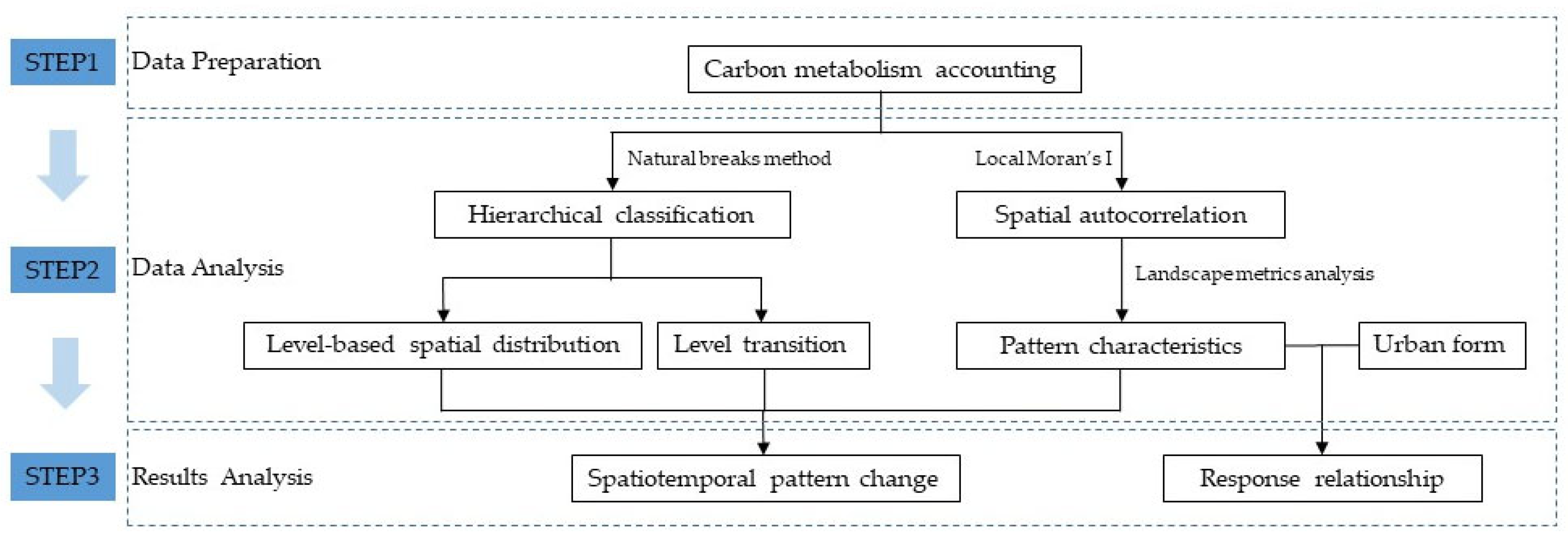
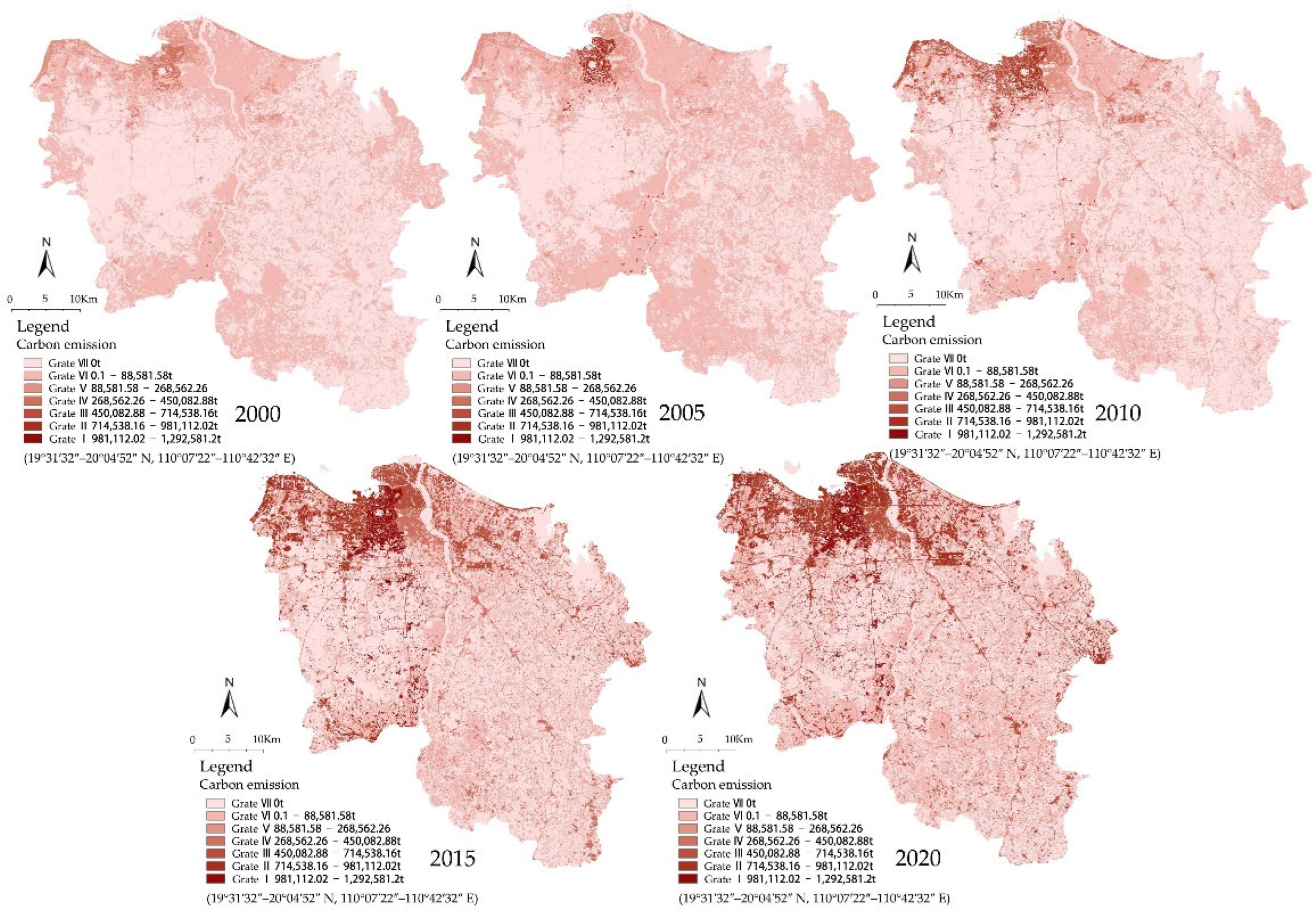

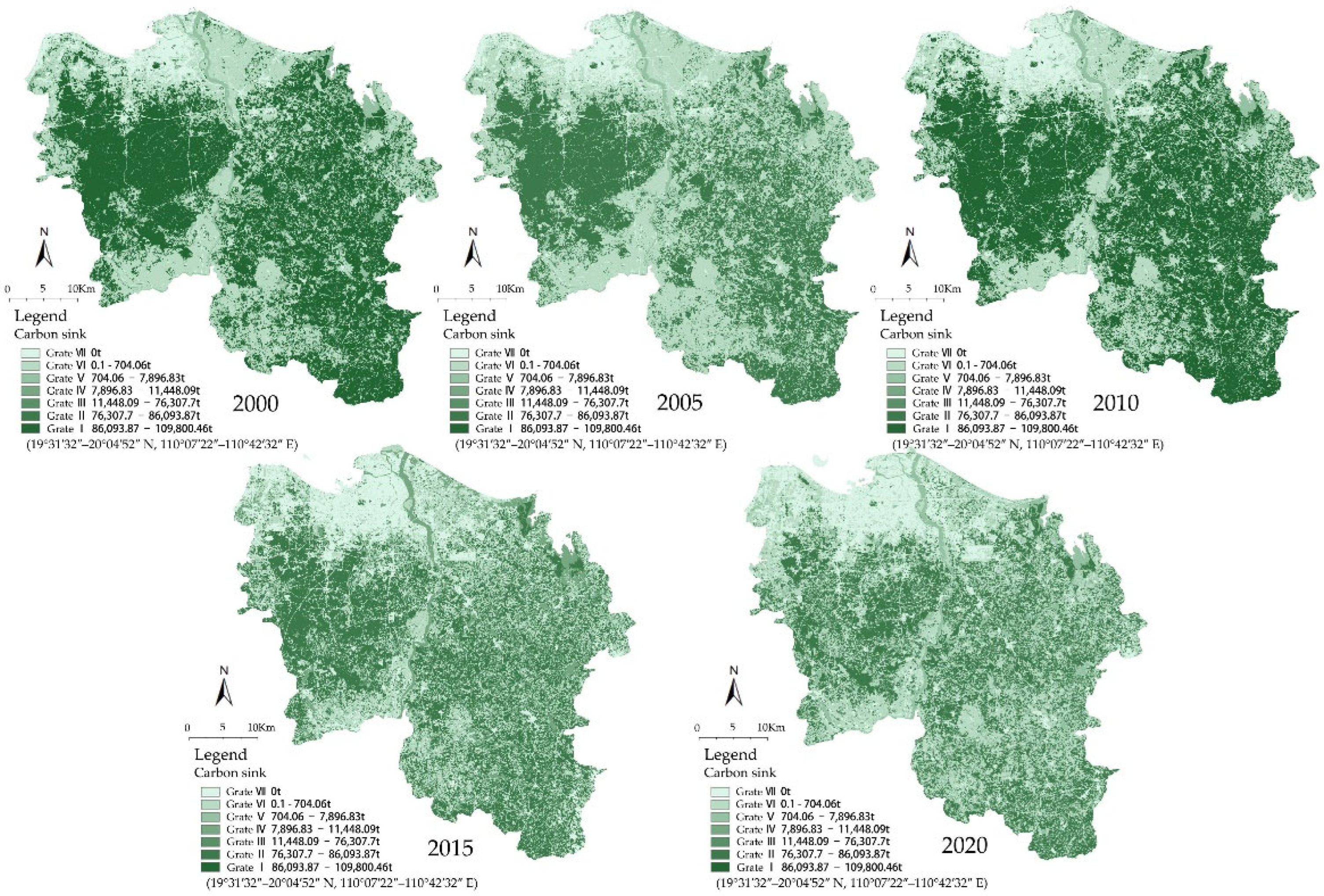




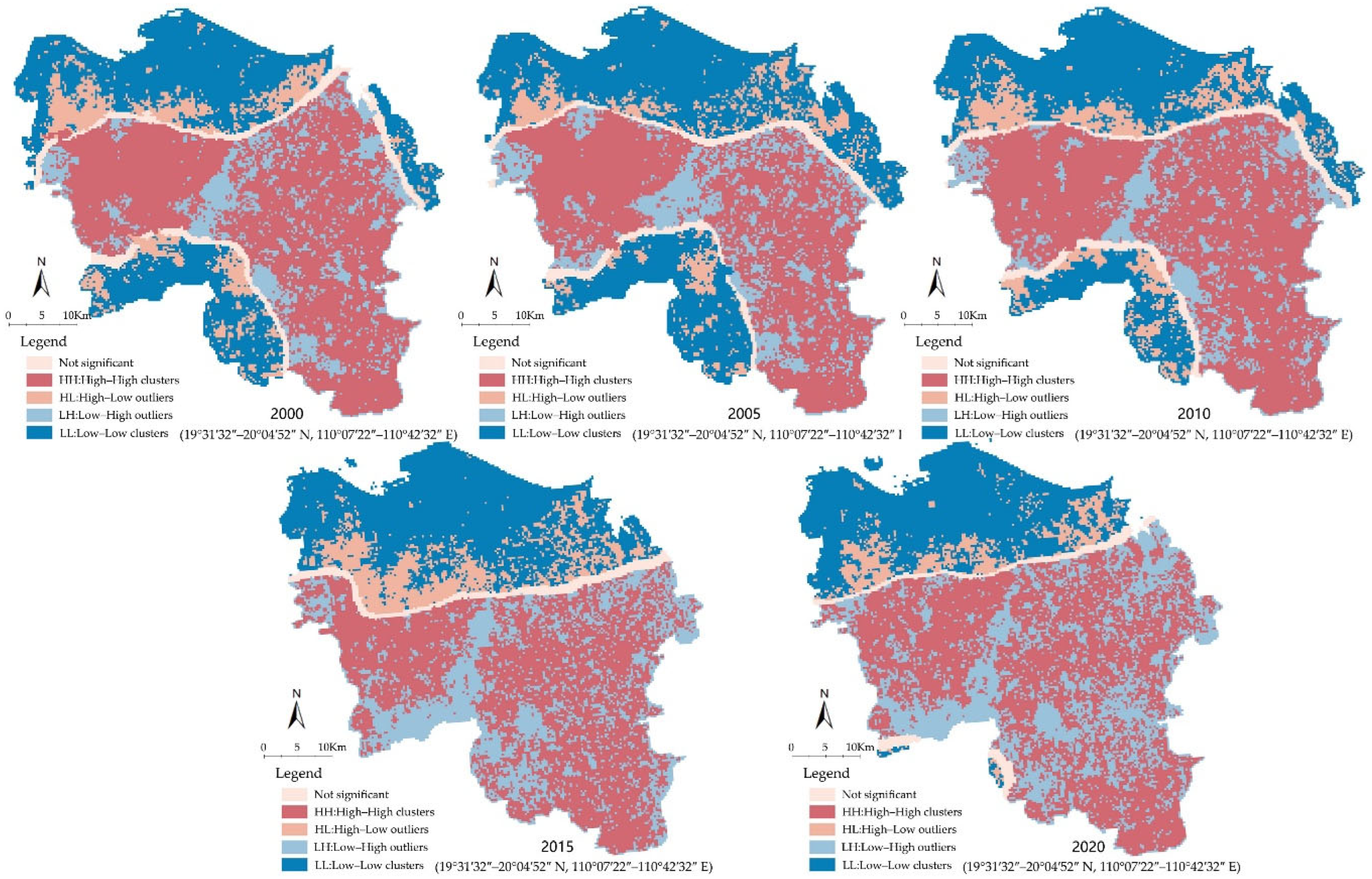



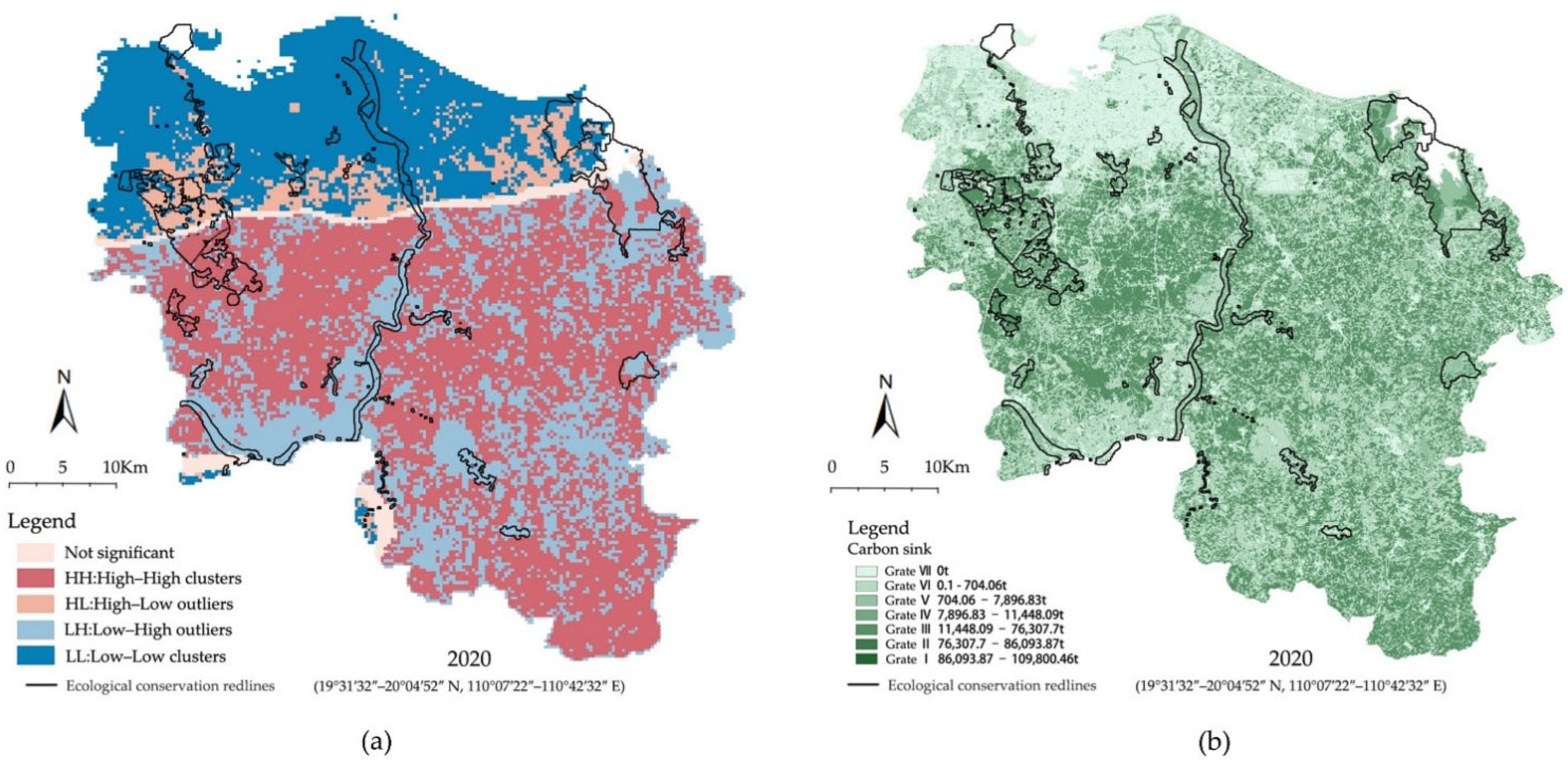
| Activities | Carbon Emission Coefficient | Units | Source |
|---|---|---|---|
| Energy | is the carbon emission factor of the i-th energy source, and Ai, Bi, Ei represent its average low calorific value, carbon content per unit calorific value, and carbon oxidation rate, respectively. | Kg/TJ | [32,35] |
| Irrigation | 266.48 | kg/ha | [36] |
| Agricultural machinery | 0.18 | kg/kW | |
| Fertilization | 0.858 | kg/kg | |
| Private car | 0.223 | kg/km | [37] |
| Road transportation | 0.056 | kg/t·km | [38] |
| Railway transportation | 0.017 | kg/t·km | [38] |
| Category | Carbon Sink Coefficient | Units | Source |
|---|---|---|---|
| Forest | 87 | t/km2·yr | [42] |
| Water | 56.7 | t/km2·yr | [41] |
| Grassland | 13.8 | t/km2·yr | [40] |
| Cultivated land | 0.7 | t/km2·yr | [43] |
| Indices | Formula |
|---|---|
| CA, class area | |
| PD, patch density | |
| AI, aggregation index | |
| LP, largest patch index | |
| COHESHION, Patch Cohesion Index | |
| PLADJ, Percentage of Like Adjacencies | |
| PAFRAC, fractal dimension index |
| Carbon Emission | 2000 | 2005 | 2010 | 2015 | 2020 |
|---|---|---|---|---|---|
| Industrial land | 352,747.46 t | 497,374.44 t | 733,542.97 t | 853,539.94 t | 545,004.12 t |
| Residential land | 186,106.30 t | 243,713.65 t | 570,625.16 t | 1,172,909.89 t | 1,424,156.77 t |
| Transportation land | 117,370.06 t | 145,918.47 t | 881,137.49 t | 1,916,912.63 t | 3,113,727.81 t |
| Other construction land | 248,143.23 t | 495,788.88 t | 785,790.96 t | 1,167,276.67 t | 1,572,315.82 t |
| Cultivated land | 129,641.54 t | 51,313.43 t | 88,861.74 t | 96,008.60 t | 98,888.10 t |
| Carbon Emission | 2000 | 2005 | 2010 | 2015 | 2020 |
|---|---|---|---|---|---|
| Forest | 106,622.24 t | 83,797.12 t | 109,738.30 t | 86,094.09 t | 76,282.50 t |
| Water | 6730.89 t | 6950.04 t | 7264.15 t | 11,447.54 t | 7715.81 t |
| Grassland | 96.13 t | 159.37 t | 314.88 t | 414.60 t | 462.75 t |
| Cultivated land | 544.51 t | 704.06 t | 460.99 t | 496.79 t | 608.33 t |
| Indices | 2005 | 2010 | 2015 | 2020 | |
|---|---|---|---|---|---|
| Carbon emission core area | PAFRAC | ↗ | ↗ | ↘ | ↗ |
| HH area | LPI | ↗ | ↗ | ↗ | ↗ |
| AI | ↗ | ↗ | ↘ | ↗ | |
| HL area | CA | ↗ | ↗ | ↗ | ↗ |
| AI | ↗ | ↘ | ↗ | ↘ | |
| Carbon sink core area | PAFRAC | ↗ | ↘ | ↗ | ↗ |
| HH area | CA | ↘ | ↗ | ↘ | ↗ |
| PD | ↗ | ↘ | ↗ | ↗ | |
| AI | ↘ | ↗ | ↘ | ↘ | |
| LH area | CA | ↗ | ↘ | ↗ | ↗ |
| COHESHION | ↗ | ↘ | ↗ | ↗ | |
| AI | ↗ | ↘ | ↗ | ↗ |
Disclaimer/Publisher’s Note: The statements, opinions and data contained in all publications are solely those of the individual author(s) and contributor(s) and not of MDPI and/or the editor(s). MDPI and/or the editor(s) disclaim responsibility for any injury to people or property resulting from any ideas, methods, instructions or products referred to in the content. |
© 2025 by the authors. Licensee MDPI, Basel, Switzerland. This article is an open access article distributed under the terms and conditions of the Creative Commons Attribution (CC BY) license (https://creativecommons.org/licenses/by/4.0/).
Share and Cite
Zhang, Z.; Fu, H.; Feng, X.; Li, S. Analysis of the Evolution of Land Use Carbon Metabolism Patterns and the Response to Urban Form Changes in Haikou, China. Land 2025, 14, 2265. https://doi.org/10.3390/land14112265
Zhang Z, Fu H, Feng X, Li S. Analysis of the Evolution of Land Use Carbon Metabolism Patterns and the Response to Urban Form Changes in Haikou, China. Land. 2025; 14(11):2265. https://doi.org/10.3390/land14112265
Chicago/Turabian StyleZhang, Zuoyuan, Hui Fu, Xiaocui Feng, and Shuling Li. 2025. "Analysis of the Evolution of Land Use Carbon Metabolism Patterns and the Response to Urban Form Changes in Haikou, China" Land 14, no. 11: 2265. https://doi.org/10.3390/land14112265
APA StyleZhang, Z., Fu, H., Feng, X., & Li, S. (2025). Analysis of the Evolution of Land Use Carbon Metabolism Patterns and the Response to Urban Form Changes in Haikou, China. Land, 14(11), 2265. https://doi.org/10.3390/land14112265






